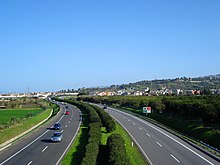
Back طريق مزدوج Arabic দ্বিবিভক্ত মহাসড়ক Bengali/Bangla Autovia Catalan Rychlostní komunikace Czech Autobahnähnliche Straße German މާމަގު DV Autovía Spanish Autobia Basque Utovía EXT راه دوبانده Persian





A dual carriageway (BrE) or a divided highway (AmE) is a class of highway with carriageways for traffic travelling in opposite directions separated by a central reservation (BrE) or median (AmE). Roads with two or more carriageways which are designed to higher standards with controlled access are generally classed as motorways, freeways, etc., rather than dual carriageways.
A road without a central reservation is known as a single carriageway regardless of how many lanes there are. Dual carriageways have improved road traffic safety over the years and over single carriageways and typically have higher speed limits as a result. In some places, express lanes and local or collector lanes are used within a local-express-lane system to provide more capacity and to smooth out traffic flows for longer-distance travel.